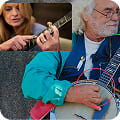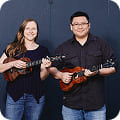Harmonica with Howard Levy


Preview this school

Master the Harmonica with Howard
Each lesson builds on the last, taking you from zero to hero!

Master harmonica with virtuoso Howard Levy. Over 250 lessons spanning blues, jazz, classical, and world music to unlock techniques like advanced bending, overblows and overdraws.
Basic Harmonica
Explore harmonica basics through tunes, breathing, positions, and foundational techniques.
Blues
Learn bending, tongue blocking, overblows, and blues improvisation across multiple positions.
Intermediate Harmonica
Build expressive technique with bends, positions, scales, and diverse musical styles.
Jazz
Learn expressive jazz and world music on harmonica with advanced bends, licks, and theory.
Advanced Harmonica
Build mastery with advanced bending, overdraws & overblows, jazz harmony, and classical phrasing.
Indian/Middle Eastern/Eastern European
Discover modal playing and non-Western sounds through bending, scales, time signatures and world melodies.
30 Day Challenge
Virtuoso Harmonica
Explore advanced jazz tunes and exercises to build speed, fluency, and expressive soloing.
Folk/Irish/Bluegrass
Learn folk and traditional melodies while exploring positions, scales, and transposing techniques.
Latin/Brazilian
Explore Latin styles and melodies through bending, montunos, and expressive phrasing.
Rock/Pop
Explore iconic pop and rock melody styles while refining tone, phrasing, and expression.
Classical
Learn timeless classical pieces while developing phrasing, tone, and tongue block control.
Rhythms of the Breath - Volume 1 -NEW!
Learn foundational drum rudiments to build breath control and coordination, control, and rhythmic confidence.
Get Personal Feedback with Video Exchange
Get custom video lessons from your instructor by sending a video of your playing.

How It Works?

1. Submit Your Video
Record and upload directly through our platform. No technical skills required.

2. Get Expert Feedback
Receive personal video responses from Howard Levy with tips to improve!

3. Learn from Community
Browse exchanges from other students to learn from their questions.
Join Students Thriving with Howard Levy!

I think ArtistWorks is really great! I would recommended everyone, who would like to play or play better! I have been playing the guitar since 25 years, and I tell, by using ArtistWorks I became a much better player only in a few months.
Marton U.
Student for 1 year
ArtistWorks is a great place for musicians. The teachers are excellent and the structure of the lessons leads to improvement.
Reinhard
Student for 13 years
I did not know that online education could be this personalized or this effective. The Virtual Exchanges are priceless, yet only cost me a few dollars per submission. ArtistWorks has created an online learning environment I did not know was possible.
Marc H.
Student for 1 yearAbout Harmonica with Howard Levy
Howard Levy has taken his entire knowledge of playing harmonica and poured it into a comprehensive video library that includes hundreds of lessons in a wide variety of genres. Subscribers get unlimited access to all online harmonica lessons, supplemented by backing tracks and other study materials. Plus there's special guests, exclusive interviews, and a community of harmonica enthusiasts from all over the world. What ultimately sets these harmonica lessons apart from other online offerings however, is the ability to submit a video using the ArtistWorks Video Exchange® learning platform. Howard reviews each submission and records a video response where he offers tips and techniques to practice. All students can access Howard's Video Exchange library, which has been expanding since 2009 and may contain the key to unlock your own playing.
About Howard Levy
Howard Levy is a master of harmonica. As the first person to play the diatonic harmonica as a fully chromatic instrument, Howard opened a world of new possibilities for the instrument. After he pioneered "overblowing" and "overbending" techniques, Howard was able to journey outside the realm of traditional harmonica music and explore other genres including Jazz, Classical, Latin and other styles of World Music.As a recording artist, Howard has played on hundreds of albums and several movie soundtracks. Aside from his prolific work as a solo performer, he is a founding member of the group Bela Fleck and The Flecktones, who in 2011 won a Grammy for the song "Life in Eleven", which Howard co-wrote. Howard also plays in the groups Trio Globo, The Howard Levy 4, Acoustic Express; and has recorded collaborations with Anthony Molinaro, Chris Siebold, Rabih Abou Khalil, and many others.Howard has been showing people how to play harmonica since 1972 and teaching harmonica lessons online with ArtistWorks since 2009.
What students are saying!
Artist Works Howard Levy
I like this kind of learning very much. Howard Levy is a really great teacher. He is a genius harp player and lifted me after 55 years of playing to much higher levels. (I´m also a...
LEARNING FROM A MASTER
I´m finishing the course and I´m very happy. When I see my first videos I can see that I´ve learned quite a lot. Howard hardly never gives you a tablature. You have to play the son...
Howard Levy Harmonica
Just a small number of video exchanges with Howard brought invaluable insights. I'm glad I came back again for more.
Professional teaching level, explaining every tiny detail. Packed with tons of extra material
Well structured with clear explanations. After going through the course you will have to do only one thing to be a good musician: PRACTICE
harmonica
He explains the basics of harmonica well.
Fantastic !
I played harmonica for35 years by now. And for the last years, I stayed on the same level, without learning new things. But with the course of Howard Levy,it is as if the aeroplane...
Excellent instruction
Howard, provides well structure instruction that is well paced, explained and supported.
Harmonica with Howard Levy
Howard is clearly a nice guy extremely knowledgeable and he seems to enjoy teaching! I am an absolute beginner with the harmonica and I am looking forward to taking classes with hi...
Enjoying the school!!
I am really enjoying the harmonica school with Howard Levy. This is exactly what I was looking for in order to bring my playing up to the next level. Howard is an excellent teacher...
Harmonica Bloc...
The lessons are great... I find that I am lacking motivation to practice...
4.9 Rating

